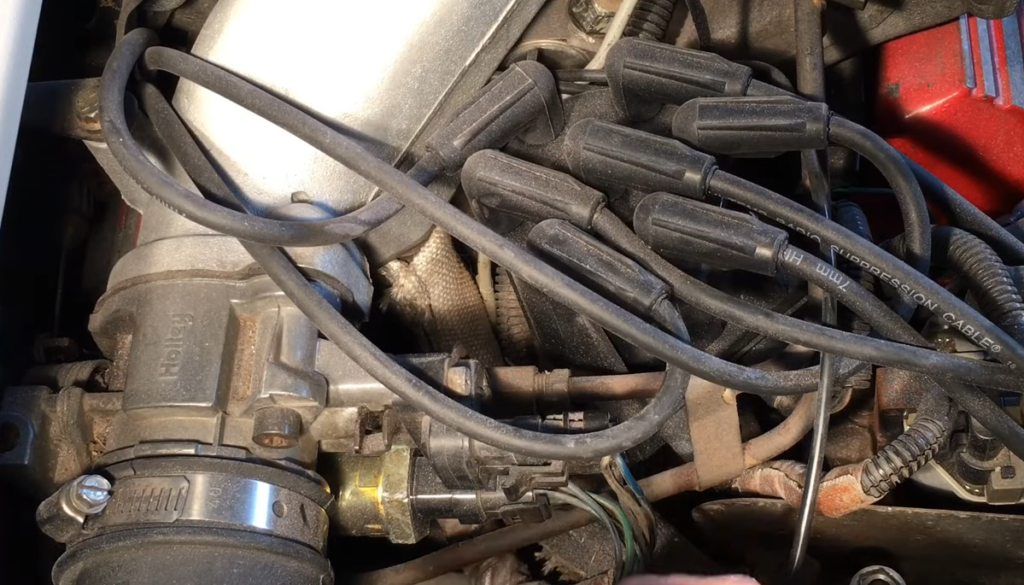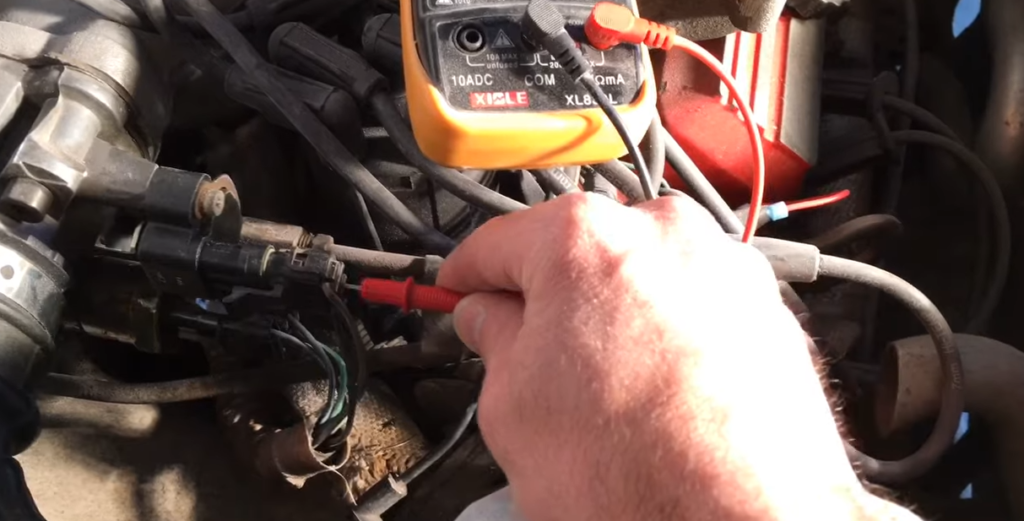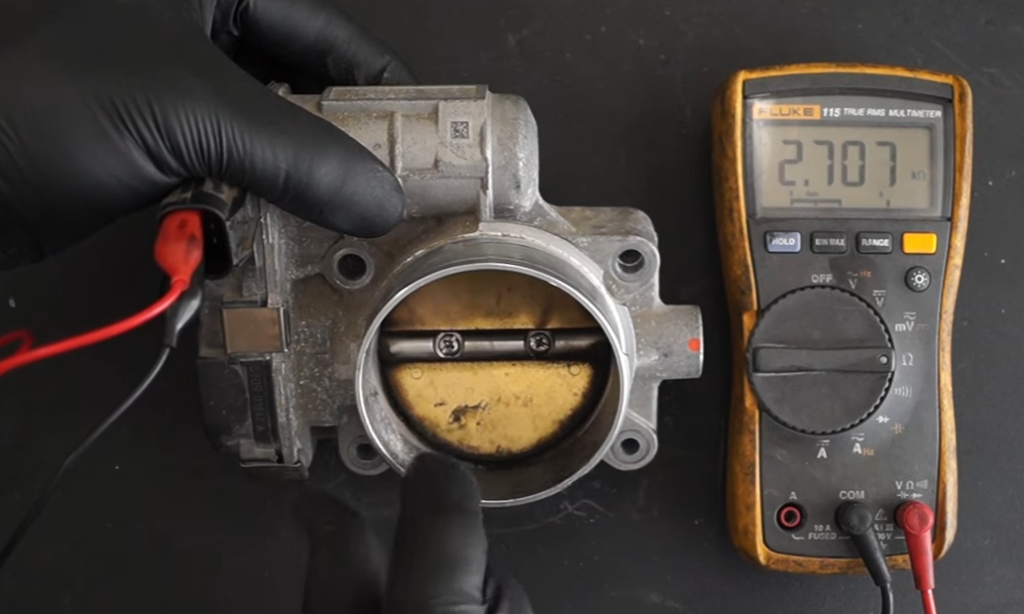Testing the throttle position sensor on your car is a crucial part of regular maintenance. If your car isn’t accelerating or decelerating correctly, the throttle position sensor may be to blame. In this article, we will teach you how to test the throttle position sensor using a multimeter. We’ll also provide some common symptoms of a bad throttle position sensor so that you can troubleshoot it if necessary.
What Is A Throttle Position Sensor?
The sensor is located on the throttle body and measures the angle of the throttle valve. This information is then sent to the engine control unit (ECU), which uses it to adjust the fuel mixture and ignition timing.
If the throttle position sensor is not working properly, it can cause a number of problems, such as reduced fuel economy, increased emissions, and even engine stalling. That’s why it’s important to test the sensor regularly with a multimeter.

The TPS consists of a potentiometer that produces a varying voltage signal based on the position of the throttle butterfly valve. The ECU uses this signal to determine how much fuel to inject and when to fire the spark plugs.
The sensor works by changing resistance as the throttle valve is moved. When the throttle is closed, the sensor has a high resistance. As the throttle is opened, the resistance decreases. The ECU uses this information to adjust the fuel mixture and ignition timing accordingly. [1], [2], [3]
What Are The Symptoms Of A Faulty Throttle Position Sensor?
There are several symptoms that can be caused by a faulty throttle position sensor. It’s important to be aware of these so that you can take action to fix the problem before it causes serious damage to your engine.
Decrease in fuel economy
One of the first things you’ll notice if your throttle position sensor is going bad is a decrease in fuel economy. This is because the sensor is responsible for sending information to the engine control unit about how much throttle input there is. If it’s not working correctly, the ECU won’t be able to adjust the fuel mixture accordingly, and you’ll end up using more gas than you should.
Sudden idle surges
If you notice your engine idling erratically, it’s important to have it checked out as soon as possible.
A throttle position sensor that is not functioning correctly can also cause your engine to idle roughly. This can be extremely frustrating and make it difficult to drive smoothly.
Sudden surges in speed
The most dangerous symptoms of a faulty throttle position sensor are sudden surges in speed. This can happen without any input from the driver and can easily lead to an accident.
The reason this happens is because the throttle position sensor is responsible for telling the engine how much fuel to inject. If it’s not working correctly, then too much fuel will be injected and the engine will accelerate uncontrollably.

Hesitation while accelerating
Another symptom of a faulty throttle position sensor is hesitation while accelerating. If you press down on the gas pedal and the car doesn’t respond immediately, it’s a sign that something is wrong with the TPS. [1], [2], [3]
How To Test Throttle Position Sensor With Multimeter
Now that we know the symptoms of a faulty throttle position sensor, let’s talk about how to test it. The best way to do this is with a multimeter.
A multimeter is an essential tool for any car owner as it can be used to test a variety of different electrical components. It’s relatively inexpensive and easy to use, so there’s no excuse not to have one in your toolbox.
For this test, we will be using a digital multimeter. This is the most accurate type of multimeter and will give you the best chance of getting an accurate reading.
Clean the Throttle
It is important to make sure that the throttle position sensor is clean before you start the test. Over time, dirt and grime can build up on the sensor, which can cause it to give inaccurate readings. Any dirt or debris on the sensor will interfere with the reading and could give you an inaccurate result.
Before you clean the sensor, you will need to disconnect the air cleaner assembler. This will give you better access to the throttle position sensor. Once the air cleaner assembly is removed, you can clean the throttle position sensor with a rag or brush. Make sure that you remove all of the dirt and grime before you proceed with the test. You can also use compressed air to blow any dirt out of the sensor’s crevices. Just be sure to avoid getting any water on the sensor as this can damage it.

After you cleaned the throttle, test if it opens and closes smoothly. If it feels sticky, you may need to replace it. [1]
Locate the throttle position sensor grounding
Now that the throttle position sensor is clean, you can proceed with the test. The first thing you need to do is locate the grounding point for the sensor. This is usually a metal screw or bolt that is attached to the body of the car.
Set the multimeter to DC voltage mode
Once you have located the grounding point, you can attach the black lead from the multimeter to it. Then, set the multimeter to DC voltage mode. This is usually done by turning the dial on the front of the multimeter to the “V” position.
Besides choosing the exact voltage type, you will also need to set a range. For this test, we recommend using the 20V range. This will give you plenty of room to work with and will ensure that you get an accurate reading.
Probe the throttle position sensor
Now it’s time for some actual testing! Turn the ignition on but don’t start the engine. Then, take the red lead from the multimeter and touch it to the positive battery terminal. Next, touch the black lead to the throttle position sensor’s signal wire. TPS will usually have more than one wire, so you will want to test each one individually.
As you move the throttle position sensor, you should see the voltage on the multimeter fluctuate. Look for the voltage reading of 12V, this is the ground wire. If you found this reading, it means your throttle position sensor is grounded properly. If you didn’t find this reading, it means that your throttle position sensor is faulty and will need to be replaced. [1]
Finding the reference voltage terminal
Once your throttle position sensor has passed the ground test, you can move on to the reference voltage test. This test is used to find the reference voltage terminal on your throttle position sensor.

Re-adjust your multimeter to 10 DC voltage
Without turning the ignition off, re-adjust your multimeter to 10 DC voltage. Again, make sure that you are using the correct voltage type for your car. You can consult your car’s manual if you are unsure what voltage type to use.
Probe the throttle position sensor
Once you set a new setting for your multimeter, it’s time to probe your TPS again. This time, touch the ground TPS terminal with the black multimeter lead and each of the other terminals with the red multimeter lead.
Check the reading
The last step is to check your TPS reading on the multimeter. If one of the terminals shows you a reading of 5V or close to 5V, it means that you have found the reference voltage terminal. However, if all the readings are close to 0V or there is no reading at all, it means that your TPS is defective and needs to be replaced.
Now that you know what the two of the three terminals are, be sure to mark them! This will save you a lot of time when it comes to testing the TPS.
But what about the third terminal?
This terminal is usually connected to the ground but it can also be left open. Since we already found out what the other two terminals are working, it leaves the third terminal as the signal return terminal. In the next section we will test this terminal to make sure everything is working properly! [1]
Testing the signal return terminal
Lastly, you will need to test the signal return terminal of the TPS. This test will give you a concrete idea of how well the TPS is functioning. We will be testing the signal terminal when it opens, closes or is in the middle range.
Insert the wires back into the TPS
But before we proceed with the test, we need to do one more thing- insert the wires back into the TPS. This shouldn’t cause you any trouble, as all you need to do is match the colors and screw the wires back in place.
Set the multimeter to 10V DC range
If you made it this far, congrats- you are now ready to test the TPS! First things first, you need to set your multimeter to the 10V DC range if you didn’t already. This is essential, as you want an accurate reading.
Probe the TPS
Next, you will need to probe the TPS. For this test, you will be probing the ground terminal and the signal terminal. Connect the black probe to the ground terminal and the red probe to the signal terminal wires. To ensure the connection stays secure throughout testing, we recommend using alligator clips.
Test the TPS in the closed position
Now that you have everything set up, it’s time to test the TPS in the closed position. Start by turning the multimeter on and placing your finger over the end of the throttle cable so that it doesn’t move. Then, take a look at the multimeter- it should read close to around 0.2-1.5 volts. If not, this is an indication that there is something wrong with your TPS and you will need to replace it.
Test the TPS in half-open and fully open positions
Begin to gradually open the throttle and stop when it reaches the half-open position. Observe the changes on the multimeter as you open the throttle. The reading should gradually increase and reach 3.5-5 volts when the throttle is fully open. If the multimeter doesn’t show these readings, it’s likely that your TPS needs to be replaced. [1]
Testing TPS with an OBD Scanner
Besides a multimeter, you can also test the TPS with an OBD scanner. This tool is very useful as it can provide you with accurate readings and diagnosis codes.

First, connect the OBD scanner to the vehicle’s diagnostic port. Once it’s properly connected, turn the ignition on but don’t start the engine.
Then, pull up the vehicle information from the car’s ECU. Once you have the data, look for the meaning of the code you got. Codes from P0120 to P0124 will always indicate a problem with TPS.
Once you confirm the issue, erase all the codes and perform a driving cycle test. Don’t forget to unplug your scanner! Start the engine and check whether or not the Check Engine Light bulb turns off. If it does, then there’s no serious issues and the malfunction was caused by jumps in temperature.
If it doesn’t come off, you may need to do a 10 min test drive and analyze the live data graph from the scanner. Look for sudden changes in the TPS readings. Its results should lead you to what is causing the problem. [4]
FAQ
How do you check a TPS with a multimeter?
To check your TPS with a multimeter, you’ll want to set your multimeter to DC voltage. Then, connect the red lead to the signal terminal of the TPS and black lead to the ground. Test your TPS when it’s fully closed, when it’s being opened and when it’s completely open. You should see a corresponding change in voltage for each position.
What voltage should a throttle position sensor have?
There is no definitive answer to this question as the voltage output of a throttle position sensor can vary depending on the make and model of the vehicle. However, in general, most throttle position sensors will have an output voltage of between 0.2-1.5 volts when fully closed and 3.5-4.5 volts when fully open.
What are the symptoms of a faulty throttle position sensor?
There are a few symptoms that may arise if your throttle position sensor is not functioning correctly. You may notice that your car’s idling is rough and inconsistent. The engine may also stall frequently, or have difficulty starting up. If you’ve been driving and step on the accelerator, there may be a delay before the car responds, or it may lack power altogether.
Do TPS get bad easily?
TPS sensors are not known to go bad very easily. However, like any other sensor, they can fail eventually. If your TPS is starting to act up, it’s important to get it checked out as soon as possible.
Useful Video: How To Test A Throttle Position Sensor (TPS)
Conclusion
As you can see, a throttle position sensor is an irreplaceable part of any modern car. By testing it regularly, you can avoid many serious problems and save yourself a lot of money. Faulty TPS can cause all sorts of engine performance issues, so it’s definitely worth your while to learn how to test it. And it can endanger your own safety and the safety of other people on the road.
Fortunately, testing a TPS is not difficult, and you can do it yourself with a multimeter. In this article we have explained how to identify the terminals of the TPS, how to test it with a multimeter, and what are the most common symptoms of a faulty TPS.
In addition to that, we also added some tips on the alternative testing method – using an OBD scanner. We hope this article was useful to you and that you will now be able to quickly and easily test your throttle position sensor if necessary. If you have any questions or comments, please feel free to leave them in the section below. Until next time!
References
- https://electrouniversity.com/how-to-test-throttle-position-sensor-with-multimeter/
- https://www.yourmechanic.com/article/symptoms-of-a-bad-or-failing-throttle-position-sensor
- https://www.carsdirect.com/car-repair/how-to-tell-if-you-have-a-faulty-throttle-position-sensor
- https://www.myvehicle.ie/car-news/how-to-check-the-throttle-position-sensor-with-a-scan-tool-














Leave a Reply